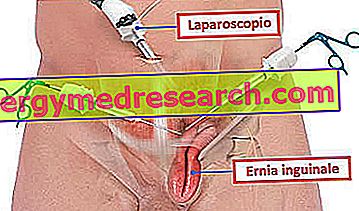Generality
The intervention of inguinal hernia is the surgical procedure for the "patching" of the weakened abdominal wall area, from which the viscera triggering the hernia emerges.
Surgeons resort to such surgery when the inguinal hernia causes severe pain or is particularly severe.

There are two methods of intervention: the traditional surgery procedure ("open") and the laparoscopic procedure.
Except for complications, the patient is discharged the same day as the operation and, after a couple of weeks, can resume the lighter daily life activities.
What is inguinal hernia
A hernia is the escape of a bowel, or a part of it, from the cavity that normally contains it (NB: the word viscera indicates a generic internal organ).
An inguinal hernia is the exit, at the level of the groin and precisely in the direction of the so-called inguinal canal, of an abdominal bowel; this leak is due to a collapse of the muscular wall of the lower abdomen (abdominal wall) and determines the formation of a localized swelling, sometimes even well visible.
The bowel that most commonly causes an inguinal hernia is the intestine ; however, it is not excluded that the bladder or a portion of adipose tissue (which is not really an organ, but can still reside near the inguinal canal) can escape.
The exact site of the swelling varies according to where the viscera reaches, within the inguinal canal. In this regard, readers should be reminded of what the inguinal canal is: it is an anatomical structure, similar to a conduit, that crosses the entire abdominal anterior wall and inside which the blood vessels pass in man of the spermatic cord and, in the woman, the round ligament of the uterus .
When present, the symptoms of an inguinal hernia consist mainly of: suffering, pain and a sense of tension, all three corresponding to the swelling.
EPIDEMIOLOGY OF INGUINAL HERNIA
The inguinal hernia is the most common type of hernia.
Men suffer the most, since they have an anatomically more inguinal canal than women, which are more prone to leaking abdominal viscera.
To get an idea of how widespread inguinal hernia is in male subjects, consider that, according to various statistical studies, more than 25 men out of 100 suffer from this disorder at least once in their lives.
The inguinal hernia is typical of middle-aged adults, but can also occur in children and the elderly.
What is the intervention?
The intervention of inguinal hernia is the surgical operation aimed at repairing the muscle failure that led to the exit, in the inguinal canal, of an abdominal bowel.
Obviously, with the repair of the abdominal wall, the escaped bowel is replaced by the operating doctor in its original location.
When you run
Doctors believe it is appropriate to operate an inguinal hernia when:
- The symptoms caused by visceral leakage are serious and incompatible with a normal life.
- The spilled intestinal portion is occluded and this occlusion causes nausea, vomiting and stomach pain.
- The spilled intestinal portion suffers a " choke ". By "choking" we mean the situation in which the correct blood supply to the herniated intestinal area (that is to say leaving its seat) is missing. Without the right blood supply, the intestinal cells (as well as all the cells of the body) undergo death by lack of oxygen and nourishment. The "narrowing" of an inguinal hernia represents a medical emergency to be treated promptly.
risks
Inguinal hernia surgery is a fairly safe routine procedure, but like any surgical operation, it can lead to complications. In the specific case, these complications consist of:
- Accumulation of blood or peritoneal fluid in the space of the inguinal canal which was occupied by the inguinal hernia.
- In humans, swelling and bruising at the testicles and / or at the base of the penis.
- Permanent damage to the passing nerves near the inguinal canal; this damage to the nervous structures is manifested by pain and a sense of numbness in the operated inguinal region.
- Relapse, or the reappearance, at a distance of time and at the same point, of another inguinal hernia.
- Damage to internal viscera (for example the intestine).
- Hemorrhages, infections, formation of blood clots in the veins, stroke or heart attack during the operation, allergic reaction to anesthetic or sedative drugs given to the patient etc. These are the typical complications of any surgery performed under anesthesia and which involves more or less extensive skin incisions.
Preparation
Inguinal hernia surgery can be performed under local anesthesia or under general anesthesia. Both solutions require special preparation.
First of all, the patient undergoes a series of clinical tests ( physical examination, blood test, electrocardiogram, etc.) and an evaluation of his clinical history .
After that, the operating surgeon (or a qualified member of his staff) will explain the methods of intervention, the possible risks, the pre- and post-operative recommendations and, finally, the recovery times.
Main pre- and post-operative recommendations:
- Before the intervention of inguinal hernia, suspend any treatment based on antiplatelet agents (aspirin), anticoagulants (warfarin) and anti-inflammatory drugs (NSAIDs), because these drugs, by reducing the coagulation capacity of the blood, predispose to serious blood loss.
- On the day of the procedure, appear at full fast since at least the previous evening.
- After the operation, be assisted by a trusted person, especially when returning home (NB: the patient cannot drive).
- If you are a smoker, stop smoking, at least until the wound is completely healed.
WHY IS CLINICAL HISTORY IMPORTANT?
Evaluating a patient's clinical history means interrogating them to know, for example, if they know they are allergic to some anesthetic drug, if they suffer or have suffered from cardiovascular problems in the past, if they take certain drugs and if, in the case of a woman, it is pregnant.
This information is valuable, because it allows you to better plan the procedure.
Attention: those suffering from diabetes or other pathologies that require constant pharmacological intake are required to inform the surgeon of their condition, so that the latter can make the appropriate changes to the standard procedure.
Procedure
A surgeon can perform an inguinal hernia surgery in two different ways:
- Through a traditional or " open " surgery
- Through a laparoscopy operation
Each method has its own advantages and disadvantages. The illustration to the patient of the pros and cons takes place, obviously, before the operation and to deal with it is generally the operating surgeon.

Figure: inguinal hernia before and after the operation. From cfmis.com
Regardless of the method used, the inguinal hernia operation lasts 30 to 45 minutes . Once completed, an observation period of several hours is foreseen: in this period of time, both the medical staff and the surgeon monitor the health conditions and vital parameters of the operated patient step by step.
If complications do not arise, discharge takes place the same day as the procedure (if the procedure took place in the morning, the patient is generally discharged late in the afternoon).
TRADITIONAL SURGERY OPERATION
Once transported to the operating room, the patient is anesthetized so that he does not feel pain. Anesthesia can be local, spinal or general.
In case of local or spinal anesthesia, the subject to be operated remains conscious for the entire duration of the operation; on the contrary, in the case of general anesthesia, the individual to be operated is asleep.
Once anesthesia has occurred, the actual operation begins; the traditional procedure involves:
- A 6-10 cm skin incision where the hernia appeared,
- Repositioning of the released bowel in its natural location
- The application of a metal mesh at the point where the abdominal wall has suffered failure. The wire mesh is intended to contain the bowels that, otherwise, would tend to come out again. In other words, the wire mesh is a kind of " patch " (in English, in fact, it is called a patch).
Once the wire mesh has been applied, the surgeon closes the incision with different stitches, which are usually resorbable (that is, they fall off themselves, with a healed wound).
"Choked" groin hernia
In the case of a "choke", the surgeon must remove the "choked" intestine (thus lifeless) and surgically rejoin the separated ends.
After the "strangled" inguinal hernia operations, a 4-5-day hospitalization is planned.
INTERVENTION IN LAPAROSCOPIA
Laparoscopy (or Video-Laparo-Surgery - VLC ) is a minimally invasive surgical technique, thanks to which the operating doctor can access the abdominal cavity and the pelvic cavity of a patient, without resorting to the large incisions required by traditional surgery "in heaven open".

Depiction of inguinal hernia intervention using laparoscopy; note the small openings necessary to introduce surgical instruments. From the site: inguinalherniatreatment.co.uk
The laparoscopic incisions, in fact, measure only one centimeter, which is sufficient to introduce the necessary surgical instruments - in the case in question - to the replacement of the escaped bowel and to the "patch".
The anesthesia required in the case of laparoscopy is general, so the patient is completely unconscious.
Surgeons have the opportunity to perform laparoscopic surgery with two different approaches:
- Pre-abdominal transabdominal route
- By totally extraperitoneal way
WHAT IS THE BEST TECHNIQUE?
Experts believe that, from the point of view of advantages and disadvantages, the two methods of intervention are equivalent. Indeed:
- The wounds following the laparoscopy operation heal much faster, as the surgical incisions are small.
- With an "open-air" operation, however, the risk of damaging the intestine through surgical instruments is lower. This is due to the fact that, during a laparoscopy, the surgeon follows his movements inside the abdominal cavity on a monitor and not directly, as happens with the open procedure.
What affects the choice of the intervention method?
The factors that influence the choice of the method of intervention are substantially two: the state of health of the patient - which if he is healthy and not old can "hold" the general anesthesia (therefore the laparoscopy) - and the experience of the surgeon in a certain operational method.
Post-operative phase
Once the most important effects of anesthesia have vanished, it is likely that the patient will experience pain at the operated area. This is a completely normal sensation, which can last a few days and for which doctors advise taking paracetamol (or a painkiller ).
PERSONAL HYGIENE
Doctors recommend maximum personal hygiene to reduce the risk of infection. All useful information on how to wash without wetting the dressings and how to keep wounds clean is explained by the medical staff at the time of discharge.
RECOVERY TIMES
The return to normal daily activities must be gradual and must take place according to the sensations felt; in other words, it is good not to force the recovery and, if you feel pain while you are carrying out a certain effort, stop immediately.
In general, for the resumption of lighter daily activities, it is sufficient to wait 1-2 weeks, while for the resumption of heavier activities, it is necessary to wait 4 to 6 weeks.
The return to work depends on the work activity itself: if the patient performs a sedentary job, 1-2 weeks of rest are enough; if, instead, the patient carries out manual work, it takes several more weeks, sometimes even 6.
To resume driving, it is advisable to wait until sitting at the wheel does not create any pain or discomfort.
Results
According to an Anglo-Saxon statistic, about one in 10 people subjected to inguinal hernia is the victim of a relapse.



